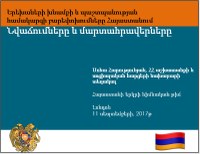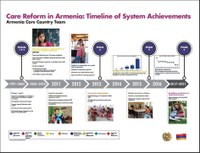Armenia
The Republic of Armenia is a small country with approximately 2.8 million people. Armenia has high life expectancy (75 years of age), relatively low infant mortality (8.8), and high educational enrolment rates (86%), though poverty remains high with just 50 percent employment and about a third of children living in poverty.
This situation, along with historical influences on institutions—such as the role of institutions during World War II, the 1988 earthquake, the collapse of the Soviet Union, refugees from Azerbijan due to the Nagorno-Karabakh conflict, and other economic crises—has resulted in many children being separated from family care and put into residential care institutions. This is particularly difficult for children with disabilities.
Armenia signed the UN Convention on the Rights of the Child in 1993, though active care reform began in 2004 through transformation of residential care institutions and special schools. The primary government agency responsible for care reform in Armenia is the Ministry of Labour and Social Affairs (MOLSA). The minister chairs the National Committee on Protection of Children, which is the upper tier of the three-tier child protection system established in Armenia in 2005.[1] Its primary role is to maintain a consistent child care reform policy across all levels of government. The Department of Family, Women and Children–Related Issues of the MOLSA is responsible for policy design and regulations for the child care system. Other key ministries involved in care reform include the Ministry of Education and Science (MOES); the Ministry of Health; the Ministry of Justice (MOJ); the Republic of Armenia Police; and the Ministry of Territorial Administration and Development (MOTAD). Very recently the MLSA started entering into social partnership agreements with nongovernmental organizations (NGOs) to expand the scope and coverage of alternative care services to children in adversity.
MEASURE Evaluation started working in Armenia in March 2017 to strengthen the local capacities of government partners to assess, address, and monitor care reform in line with the United Nations Guidelines for the Alternative Care of Children, which serve to enhance the implementation of the United Nations Convention on the Rights of the Child. MEASURE Evaluation supported the government partners to:
- Provide leadership in implementing a structured assessment of national childcare reform systems and strategies using a standardized framework/tool
- Identify gaps and continuing needs in childcare reform
- Develop plans to address priority needs
- Establish monitoring indicators and systems for regular assessment of progress and monitoring of results against country plans for childcare reform
Related Content
Learner’s Guide to Monitoring and Evaluation of Care Reform in Armenia
Assessing Alternative Care for Children in Armenia
Երեխաների այլընտրանքային խնամք Ամսագիր
MEASURE Evaluation Works to Improve the Lives of Vulnerable Children in Armenia
Improving Care for Vulnerable Children
Launch of Care Reforms Assessment Was Announced
Participatory Assessment of Care Reform Is Conducted in Armenia
[1] The three-tier child protection system of Armenia consists of guardianship and trusteeship bodies (GTB) and guardianship and trusteeship committees (GTC) at the community level; family, women, and child protection units (FWCPU) at the marz (regional) level; and the National Committee on Protection of Children at the national level.















